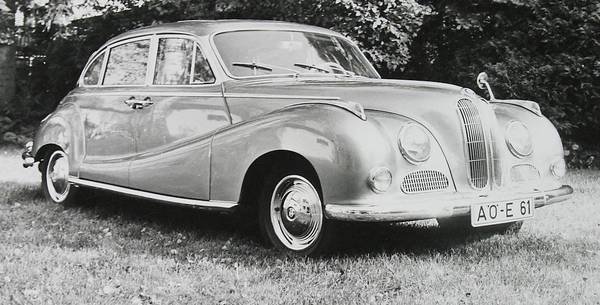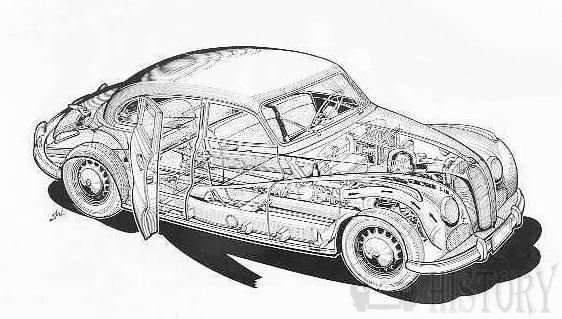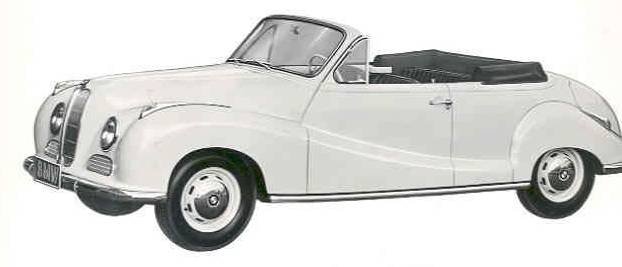BMW 501 and 2.6
| 1952 to 1962 | |
|---|---|
 | |
| Overview | |
| Manufacturer | Bayerische Motoren Werke AG (BMW) |
| Also called | BMW 2.6 BMW 2600 |
| Production | October 1952 - 1962 |
| Designer | Peter Schimanowski |
| Body and chassis | |
| Class | Full-size luxury car |
| Body style | 4-door saloon, 2-door cabriolet, 2-door coupé |
| Layout | FR layout |
| Related | BMW 502 BMW 3200 CS |
| Powertrain | |
| Engine | 1971 cc OHV straight-6 2077 cc OHV straight-6 2580 cc OHV V8 |
| Transmission | 4-speed manual |
| Dimensions | |
| Wheelbase | 2,835 mm (111.6 in) |
| Length | 4,730 mm (186 in) |
| Width | 1,780 mm (70 in) |
| Height | 1,530 mm (60 in) |
| Kerb weight | 1,340 kg (2,950 lb) or more |
| Chronology | |
| Predecessor | BMW 326 |
| Successor | BMW 2500 / 2800 ‘New Six’ |
The BMW 501 was a luxury saloon car manufactured by BMW from 1952 to 1958. Introduced at the first Frankfurt Motor Show in 1951, the 501 was the first motor car to be manufactured and sold by BMW after the Second World War. The 501 and its derivatives, including the V8 powered BMW 502, were nicknamed “Baroque Angels” by the German public. The BMW 502 was the first postwar German car to be manufactured with a V8 engine.
While the 501 and 502 model numbers were discontinued in 1958, variations of the model, with the same platform and body, were continued until 1963.
Background
Autovelo restarts "BMW" production
Production at BMW's motor car factory in Eisenach restarted in late 1945 with pre-war BMW models. However, Eisenach was in the Soviet occupation zone, and the cars were not being manufactured by BMW AG, but by the Soviet manufacturing entity Autovelo. Despite not being made by BMW, these cars bore the BMW logo and were being sold as BMWs.
Meanwhile, BMW AG restarted manufacture on a much smaller scale, starting with pots and pans, and eventually moving up to household hardware and bicycles. Eventually, with permission from the U.S. authorities and funding from the banks under which BMW had been put into receivership, they began manufacturing motorcycles in 1948.
To end Autovelo's continued trademark infringement, the Eisenach branch of BMW was dissolved effective 28 September 1949 and was legally severed as at 11 October. Without any legal arguments to continue using BMW's name and logo, Autovelo changed the name to EMW (Eisenacher Motoren Werke) and changed the blue colour in the logo to red.
Three approaches to car manufacture
Donath
Kurt Donath, technical director of BMW and general manager of the Milbertshofen factory, was soliciting manufacturers, including Ford and Simca, to produce their vehicles under licence. In particular, Donath was looking to produce old products under licence, so that he could buy tooling along with the licence.
Böning
While Donath was trying to find a car to build under licence, chief engineer Alfred Böning developed a prototype for a small economy car powered by a motorcycle engine. Called the BMW 331, the prototype used a 600 cc motorcycle engine, a four-speed gearbox, and a live rear axle. The body was designed by Peter Schimanowski and resembled a BMW 327 in miniature.
Grewenig
The BMW 331 was proposed for production to the management, where it was vetoed by sales director Hanns Grewenig. Grewenig, a banker and former Opel plant manager, believed that BMW's small production capacity was best suited to luxury cars with high profit margins, similar to the cars BMW made just before the war. To this end, he had Böning and his team create the car that would become the 501.

1955 BMW 501 x-ray view
Design and engineering
The 501 was an all-new platform, with a perimeter frame, double A-arm front suspension with torsion bar springs, and a live axle with torsion bar springs at the rear. The steering mechanism was similar to a rack and pinion system except that the rack was semi-circular instead of straight.
The 501 was powered by the M337 engine, a development of the BMW M78 used in the pre-war BMW 326.
The four-speed gearbox was not bolted to the engine, but was a separate shaft-driven unit mounted between the second and third crossmembers. While the remote gearbox placement led to a complicated linkage to the column-mounted shifter, resulting in vague shifter action, it also improved legroom for the front passengers.
The body was designed in house by Peter Schimanowski. After seeing the prototype, BMW's management commissioned Pininfarina to build an alternative. The Pininfarina prototype was thought to be too similar to his design for the Alfa Romeo 1900 saloon, so BMW stayed with Schimanowski's design. The steel body was far heavier than Schimanowski had calculated it to be, resulting in the completed car having a dry weight of 1,430 kilograms (3,150 lb).Performance suffered as a result, with a top speed of 135 km/h (84 mph) and acceleration to 100 km/h (62 mph) taking 27 seconds, both of which compared unfavourably with the six-cylinder Mercedes-Benz 220.
One innovation was the attention paid to passive safety. The car featured a robust chassis providing above average side impact protection, an unusually short steering column with the steering gear set well back from the front of the car, and a fuel tank placed in a carefully protected location above the rear axle in order to minimize fire risk in the event of an accident.
501 units produced
- 501 - 1706
- 501A - 2251
- 501B- 1371
Reception and production
The 501 was introduced to the public in April 1951 at the Frankfurt Motor Show, as was its less expensive, production-ready rival, the Mercedes-Benz 220. The 501 made an impression on the public with its solid engineering and its extravagance. Its list price of more than fifteen thousand Deutsche Mark was about four times the average salary in Germany at the time.The public nicknamed the 501 "Barockengel" (Baroque Angel) in reference to the curved, flowing style of the body.
Development issues delayed the start of production until late 1952, and even then BMW still did not have equipment for pressing body panels in operation. The first 2,045 four-door saloon bodies were built by Karosserie Baur and were shipped from Baur in Stuttgart to BMW's factory in Munich for assembly. The thousandth 501 was completed on 1 September 1953.
The 501 and derivatives built at BMW were four-door saloons. Coupe and convertible versions were available as custom orders from Baur or Autenrieth.
A road test of the 501 in March 1953 by Auto- und Motorrad-Welt reported better than average wind resistance, as well as good ride quality and an effective heating system. The fuel consumption was reported to be 10.3 L/100 km (27 mpg-imp; 23 mpg-US).

1956 BMW 501 Cabriolet
Development of the BMW 501
The 501A was released in 1954 as a replacement for the original 501 with similar trim and equipment, but which sold for DM14,180, a price reduction of more than eight hundred Deutsche Mark from the original 501. The 501B was a decontented version that sold for DM500 less than the 501A. Both the 501A and 501B used a revised M337 engine.
The engine and the model designation were altered again in the spring of 1955. The 501A and 501 B were replaced by the 501/3, with an updated M337 engine. The 501/3 was introduced alongsinde the 501 V8, which featured a detuned version of the 2.6-litre V8 introduced in the 502 the previous year. The 501/3 and 501 V8 were continued until 1958, when the six-cylinder engine and the 501 model designation were discontinued.
Rating
Technical
-
BMW 501 and 2.6 Technical details and specifications (1952-1962)
BMW 501 1952-1955
DIMENSIONS AND WEIGHT:
Wheelbase, mm/inc. - 2835/111.6
Track, front/rear, mm/in. -1322/1408.52.0/55.4
Lergth - 4730mm
width - 1780mm
height - 1530mm
curb weight, kg/lb 1340/2955ENGINE:
Engine location - Front
Number Of cylinders - 6
capacity - 1971
Bore x stroke,mm - 66X96
Horsepower @ rpm - 65@ 4400 501 A 72 @4400
Valve type - overhead
Carburetion - 1 Solex 30 PAAJ(2V)
Cooling - waterTRANSMISSION DRIVE LINE:
Drive - Rear
4-speed manualSTEERING:
Bevel GearSUSPENSION:
Front suspension - Double A-arms, torsion bars
Rear suspension - Live axle, torsion barsBRAKES:
Drum
Service brakes DrumWHEELS TYRES:
16x4E/5.5-16Production figures
501 1952 – 1954 2,125
501A & 501B 1954 – 1955 3,327
501/3 1955 – 1958 3,459
501 V8 / 2.6 / 2600 1954 – 1962 5,914© Motor car History




